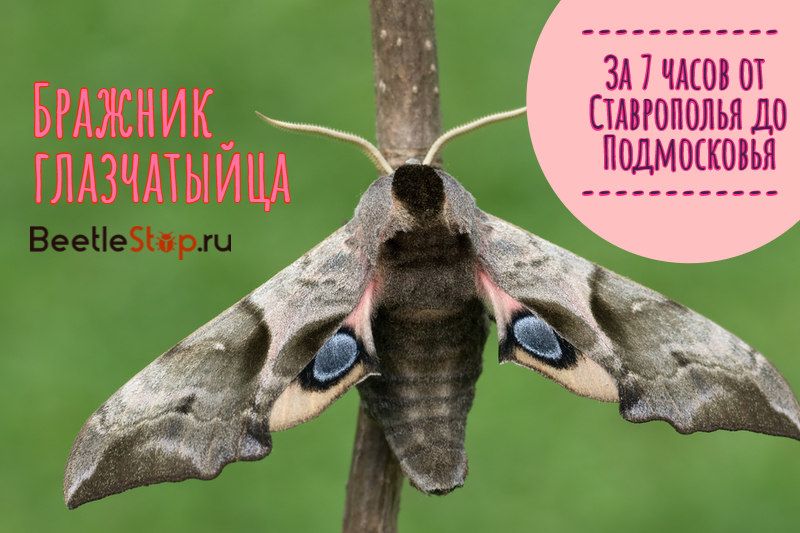Ophthalmic Hogweed - Another Miracle of Nature
The protective spots possessed by the eye-beetle hawk are drawn on the hind wings so realistically that from a short distance they can really be mistaken for natural eyes. In this bizarre drawing, you can see dark eye sockets, white apples, and a black pupil with a black rim.
Most clearly, this can be seen in a good photo of the eye-eyed hawk:

Biological Characterization and Description
Description
Ophthalmic Hogworm belongs to the family of Hogworms of the Brazhnikov family. This is a brown-gray butterfly, in which only the hind short wings stand out in bright colors. On a pinkish-red background is the famous spot in the form of an eye.
Attention! The body length of the butterfly slightly exceeds four centimeters, while the wingspan can reach 95 millimeters.
Behavior
In a calm state, the hawk mimics easily, merging with the color of the environment: tree bark, dry sticks, stones.
It is interesting that the adult insect, Ophthalmus oculosa, does not feed at all, it suffices from the reserves that its body has accumulated, being still in the form of a larva-caterpillar.
Another curious fact is the flight speed of the hawk, up to 50 kilometers per hour (!) And its ability to fly over long distances. They say that observers traced the path of the insect from the Stavropol foothills of the Caucasus to the suburbs. So, in this experiment, a butterfly’s flight for more than a thousand kilometers lasted a little over seven hours.
By the way! Many observers and researchers call hawks northern hummingbirds for the manner of flight and the ability of some species to eat through the proboscis.
In the daytime, these butterflies practically do not fly, but hide in the shade of trees or shrubs, activity begins with the arrival of twilight, and therefore, his coloring matches all night moths.
Spread
Ophthalmic hawthorn lives almost throughout Europe, with the exception of the Far North. It is found in Asia Minor, and in Kazakhstan, and in Western Siberia.
As for the zoning of settlement, this butterfly prefers to settle in bright gardens and copses, on the edges of the forest and in flood meadows - where there is always a lot of light and foliage.
Our help! Despite its widespread distribution, the abundance of Ophthalmicus harachis is small in nature. And in the Smolensk region, an insect is even listed in the Red Book.
Reproduction and development
Ophthalmic hawk wintering in pupal stage on branches of trees and shrubs or under them in foliage. With the May warm rays of the sun, the pupation stage ends and the years of butterflies begin, which, with changes, runs through the end of July. In certain warm years, a third generation is also formed, which can develop from August to October. At the same time, adult insects of different generations of the season can exist.
Attention! Brazhniki - insects with a full cycle of transformation: egg - larva - pupa - imago.
The search for a sexual partner is most often carried out by males, looking for a female by the special smell of her ferromones. Mating lasts from thirty minutes to two hours. In this case, the insects are almost in a fixed position.
The female lays testicles, rather large for insects, on the leaves of those plants that the larvae will feed on in the next stage. In the egg-laying, their number is small - 5-10 pieces, but there may be several clutches in different parts of a tree or shrub.
Milk-colored eggs are incubated quickly, for 3-5 days, depending on the ambient temperature. Soon, green caterpillars with white stripes and brown dots appear.
In addition to its characteristic coloration, the caterpillar of Ophthalmicum has another characteristic feature - the horn in the tail. Sometimes its color fancifully changes to blue or purple. This, apparently, depends on the particular feed object.
Larvae feed on the foliage of trees on which they parasitize. The following deciduous trees are used as fodder objects:
- Linden;
- maple;
- Birch tree;
- aspen;
- bird cherry;
- pear;
- Apple tree;
- plum;
- turn;
- lilac;
- poplar;
- different types of willow: crab, weeping, willow;
- alder.
Despite the gluttony of the caterpillars, the eye-beetles do not cause much harm to garden and forest plantations, due to their small numbers, and also because they feed mainly on the smallest young leaves.
After feeding and reaching the maximum size of about 80 millimeters, the larvae pupate. In this case, the caterpillars crawl into crevices and cracks on tree trunks, or, if an insect lives in meadows, into small minks and cracks in the soil. If the generation of the insect is early, then this stage lasts about three weeks; in the case of the late season, the pupa leaves for the winter.
By the way! The caterpillar stage of the hawk is the longest. It can last up to one and a half months.
Almost immediately after the last modification - the transformation of the chrysalis into a butterfly - the hawks begin to fly on their own and go in search of a sexual partner. So that the life cycle repeats over and over.
Butterfly Breeding
Many types of hawks, including Ophthalmus, are easily bred in captivity. For this, an aquarium is installed in the room and branches of deciduous trees are placed in it, on which caterpillars are planted. For pupation, soil is poured at the bottom of the tanks and old knots and pebbles are laid out.
For winter pupae, moistened sawdust or sphagnum is placed at the bottom of the aquarium. Wintering is carried out at temperatures from +5 to -10 Celsius.
The video will show the caterpillar of the Ophthalmus oculata in wildlife:


 (votes: 5, average rating: 4,20 out of 5)
(votes: 5, average rating: 4,20 out of 5)